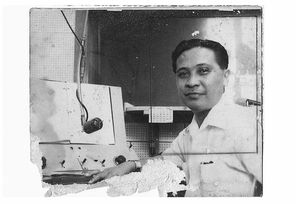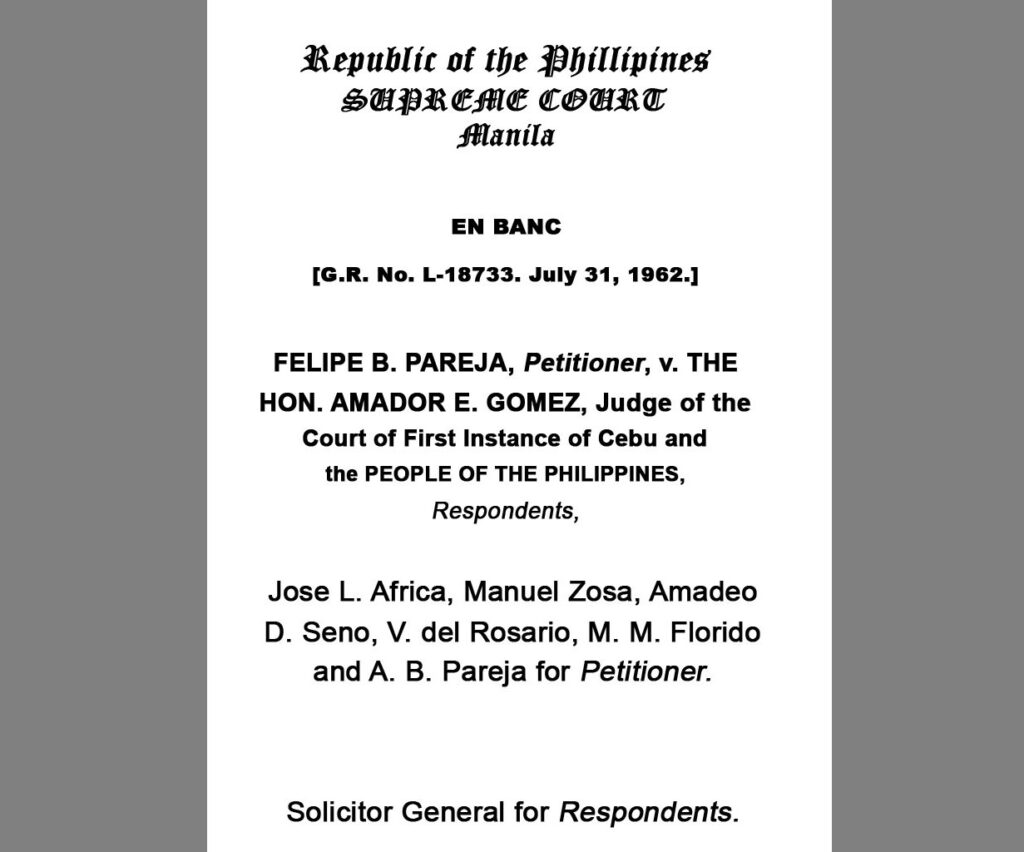What many of us didn’t know
about the 1961 murder of
Antonio Abad Tormis.
Cebu’s first press freedom martyr

Tormis edited the Republic News, wrote its editorials, ran an opinion column and, on top of that, anchored a radio commentary program. On print and broadcast platforms, he unleashed powerful attacks against wrongdoers in government. [From Tormis family files]
What many of us didn’t know about the 1961 murder of Antonio Abad Tormis.
PACHICO A. SEARES
September 2022
How the Supreme Court ruled on the the 1961 murder of Cebu’s first press freedom martyr. P400 paid to the gunman, all perpetrators caught and convicted: from wharf-hand shooter to city treasurer who ordered the killing. Why defenses of Cebu City official Felipe Pareja were rejected, what nailed the four accused. And this, most significant of the takeaways from from the 1969 high court decisions: Tormis was killed for what he wrote and broadcast in media.
So that passers by the world over will know that on this spot a newspaperman was benighted in treachery at the cost of P400 in blood money because to the end he had a free pen…
— From the original marker installed Nov. 18, 1964 at the site of the Tormis murder “at the instance” of the Provincial Press Clubs of the Philippines. Destroyed by a building renovation, the marker was replaced with a new one by the Cebu City Government under the initiative of the Cebu Citizens-Press Council (CCPC).
THE first marker installed in 1964 on the sidewalk of Borromeo St. in Cebu City highlighted an interesting fact in the murder of Antonio Abad Tormis, editor of ”Republic News” and a lawyer-broadcaster: the amount paid to the killer, which was P400, “in blood money.”
The amount paid was not disclosed in the headline or lead of stories that broke the news on the day after the shooting of July 3, 1961.

The barbershop called Esquire along Borromeo St. in Cebu City, where the lawyer-editor just had his haircut. Antonio Abad Tormis was about to drive away when the gunman pumped bullets into him.
Early stories in the news archives didn’t mention that interesting detail. These Supreme Court rulings confirmed the amount:

Landmark decision on the murder of Tormis. Check out the star-studded defense team.
(a) the decision of Nov. 29, 1969 (GR #L-21937) in People of the Philippines vs. Felipe B. Pareja, which affirmed the conviction of the Cebu City treasurer and his co-accused, and
(b) the earlier SC ruling of July 31, 1962 (GR #L-18733) , in Felipe B. Pareja vs. CFI Judge Amador Gomez and People of the Philippines, which rejected an appeal from the lower court’s denial of bail.
In September 2022, or 61 years after the murder of Tormis, a Chris Java sculpture of the journalist — showing him at work on his typewriter – was to be installed, an additional feature to memorialize him in CCPC’s CJJ Media Gallery at Museo Sugbo.
This revisit of of the litigation after Tormis was killed dwells mostly on unreported or under-reported data from the two high court decisions.
[1] P400 ‘BLOOD MONEY’ WOULD BE P50K TODAY. Today’s press would call the amount of P400 measly, paltry, snack money. But according to an inflation-converter site, P400 would pay for product or service worth P49,903.05 in 2022, at the cumulative inflation rate of 518.96%.
With the current price for contract killing in the Philippines ranging reportedly from P5,000 to P50,000, the sum of P400 in 1961 wasn’t small or cheap; it was top money.
Cesar Orongan, the self-confessed and convicted gunman, shot Tormis inside his car just as he was about to drive off from the Esquire barbershop where he had a haircut. For that, he was paid P400 and from that sum, he paid P100 to Gaspar Mesa, his fellow wharfhand at the city’s arrastre service who accompanied him during the shooting. Thus Orongan’s net pay for the job was P300.
[2] NO SAVVY IN CONTRACTING THE KILLER. From the SC records affirming the finding of guilt of the accused by the Cebu Court of First Instance, convicted Felipe B. Pareja, then the Cebu City treasurer (appointed by then president Elpidio Quirino on April 25, 1950), wasn’t skillful in covering his identity and tracks, as masterminds would now do.
He contracted shooter Orongan face to face, in his office at City Hall, in the presence of his aide/bodyguard Avelino Monzolin who had recruited Orongan.
Pareja was open and vocal about his motive to have Abad Tormis killed. He repeatedly ordered Monzolin to kill Tormis, from May until July, when the gunman was hired. When the subordinate refused each time, saying he couldn’t do it, Pareja nagged Monzolin to look for a killer instead. And he wrongly assumed that his aide/bodyguard, who knew first-hand about the plan to kill, wouldn’t turn against his boss in the face of police grilling.
In comparison, since the Pareja murder, masterminds in killing of journalists have been shielded from the people who set the stage for, or committed, the crime. No mastermind was caught in the violent takedown of a journalist – or lawyer, prosecutor, judge or any other high-profile victim – apparently after learning from the movies and Pareja’s real-life case on how to get caught.
[3] … OR IN COVERING HIS TRACKS. Pareja wasn’t adept in concealing the crime, highlighted by the finding of the murder weapon in his personal safe at City Hall.
One mistake was not getting rid of the weapon, a .32 caliber Colt revolver. He didn’t pay the P400 to Orongan until the gun was returned to him, not to be sure it was thrown away but to keep it in one of two safes in his office. At first, he said he couldn’t remember the lock combination to open his own safe, putting off the police-NBI search there, but when they returned to his office after a search at his house, he took a notebook from a shirt pocket and gave the number, and there was the revolver.
When shooter Orongan was arrested 10 days after the killing, there was a piece of paper in his wallet, on which was written “Avelino Monzolin, c/o Treasurer’s Office, Cebu City.” Another bit of evidence, along with others, that linked Pareja to the shooting.

Tormis in lawyer’s court-appearance suit (right) and at home with wife Lux Murphy-Tormis. [From Tormis family files]
[4] TORMIS ATTACKS ON PAREJA. Motive to kill was convincingly established, the SC ruled. Tormis’s articles and editorials questioned the honesty of the public official and called for administrative and criminal investigation. They included the specific charge of receiving “kickbacks” and profiting from, among others, “purchase of garbage cans, overpricing of office supplies and hospitalization loan anomalies.”
The attacks in Tormis’s platforms – the newspaper Republic News (previously named Republic Daily) where he was editor and columnist, and dyRC radio, as commentator – were described in SC records as “unrelenting (continuous, persistent) campaign,” “strong and vitriolic comments.”
[5] THE QUESTION OF FAIRNESS. The SC documents didn’t delve into the question of fairness: Were the attacks in the media against Pareja based on verifiable facts, how were they presented, was Tormis given the right of reply?
While even gross unfairness to the subject of media scrutiny won’t justify the use of violence against a media practitioner, this would’ve been interesting study for journalism students and instructive lesson for media practitioners: whether the reporting and commentary qualified as fair and the target of attack was given the right of reply.
But then, whatever the answer to that question, the violence unleashed against Tormis wouldn’t be less abhorrent.
[6] DEFENSES COULDN’T STAND. Gunman Orongan’s plea of guilt was “conclusive proof of the truth of his extrajudicial confession.” Orongan confessed to the law enforcers and admitted he was guilty before the court. The SC found that and his “willingness to pay for his crime” credible, as it did with the confessions of Mesa and Monzolin.
With the confessions of the three co-accused was the finding of the murder weapon in the steel safe of Pareja. That corroborated the confessions and made the treasurer’s claim of innocence “impossible to believe.”
The SC cited basic rules on evidence to knock down Pareja’s legal defenses, among them:
— Findings of the lower court are generally not disturbed on appeal and there were no “substantial facts” overlooked by the CFI judge that could change the result;
— Replete with details and spontaneously given, the confessions were affirmed to be voluntary;
— Confessions were evidence not only against the declarant but also against Pareja because they were “strongly indicative of the truth”;
— The prosecution’s ballistics expert was found to be more credible than the defense’s hired expert (paid with P3,000) and their finding that the three bullets that struck Tormis came from Pareja’s gun.
[7] THE TORMIS MURDER WAS AND STILL IS THE ONLY KILLING OF A CEBU JOURNALIST that was totally and quickly solved, with all the perpetrators arrested, prosecuted and convicted, and the local court’s decision affirmed by the Supreme Court. It was definitely significant in local journalism history, with the motive of the killing conclusively found to be related to the journalist’s work. Tormis was killed for what he wrote and broadcast in media.
The suspects were known in a week, all arrested in less than a month, investigated and charged on July 24, 1961 or 21 days after the murder. The accused were arraigned on Aug. 4 of the same year and convicted seven days later, on Aug. 21. The Supreme Court though still took eight years to review and affirm the lower court’s decision.
INDEED, that was a record in law enforcement and prosecution. A triumph of justice, which helped, if only for a brief period of time, beat off the culture of impunity that unsolved, unpunished killings of journalists promote.
Cebuanos and the rest of the country might see substantial improvement in solving the murders of journalists, many of which have already become cold, or even closed, cases. Sadly though, one could only be wishful to say, any day now. 
